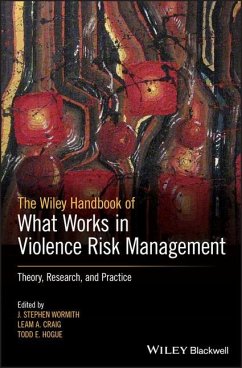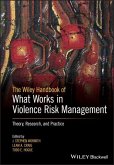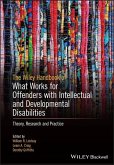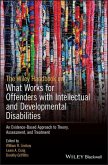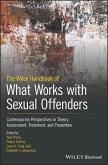The Wiley Handbook of What Works in Violence Risk Management
Theory, Research, and Practice
Herausgeber: Wormith, J Stephen; Hogue, Todd E; Craig, Leam A
The Wiley Handbook of What Works in Violence Risk Management
Theory, Research, and Practice
Herausgeber: Wormith, J Stephen; Hogue, Todd E; Craig, Leam A
- Gebundenes Buch
Andere Kunden interessierten sich auch für
![The Wiley Handbook of What Works in Violence Risk Management The Wiley Handbook of What Works in Violence Risk Management]() The Wiley Handbook of What Works in Violence Risk Management69,99 €
The Wiley Handbook of What Works in Violence Risk Management69,99 €![The Wiley Handbook on What Works for Offenders with Intellectual and Developmental Disabilities The Wiley Handbook on What Works for Offenders with Intellectual and Developmental Disabilities]() The Wiley Handbook on What Works for Offenders with Intellectual and Developmental Disabilities54,99 €
The Wiley Handbook on What Works for Offenders with Intellectual and Developmental Disabilities54,99 €![The Wiley Handbook on What Works with Girls and Women in Conflict with the Law The Wiley Handbook on What Works with Girls and Women in Conflict with the Law]() The Wiley Handbook on What Works with Girls and Women in Conflict with the Law253,99 €
The Wiley Handbook on What Works with Girls and Women in Conflict with the Law253,99 €![The Wiley Handbook on What Works for Offenders with Intellectual and Developmental Disabilities The Wiley Handbook on What Works for Offenders with Intellectual and Developmental Disabilities]() The Wiley Handbook on What Works for Offenders with Intellectual and Developmental Disabilities189,99 €
The Wiley Handbook on What Works for Offenders with Intellectual and Developmental Disabilities189,99 €![The Wiley Handbook of What Works with Sexual Offenders The Wiley Handbook of What Works with Sexual Offenders]() The Wiley Handbook of What Works with Sexual Offenders251,99 €
The Wiley Handbook of What Works with Sexual Offenders251,99 €![The Wiley Handbook on the Psychology of Violence The Wiley Handbook on the Psychology of Violence]() Carlos A CuevasThe Wiley Handbook on the Psychology of Violence229,99 €
Carlos A CuevasThe Wiley Handbook on the Psychology of Violence229,99 €![The Wiley Handbook of Personal Construct Psychology The Wiley Handbook of Personal Construct Psychology]() The Wiley Handbook of Personal Construct Psychology74,99 €
The Wiley Handbook of Personal Construct Psychology74,99 €-
-
-
Produktdetails
- Verlag: Wiley
- Seitenzahl: 608
- Erscheinungstermin: 10. Februar 2020
- Englisch
- Abmessung: 246mm x 175mm x 25mm
- Gewicht: 703g
- ISBN-13: 9781119315711
- ISBN-10: 1119315719
- Artikelnr.: 57828216
Hinweis: Dieser Artikel kann nur an eine deutsche Lieferadresse ausgeliefert werden.
- Herstellerkennzeichnung
- Libri GmbH
- Europaallee 1
- 36244 Bad Hersfeld
- gpsr@libri.de
J. STEPHEN WORMITH, PHD, was Professor in the Psychology Department at the University of Saskatchewan (U of S) and Director of the Centre of Forensic Behavioral Science and Justice Studies at U of S. He had consulted recently on correctional matters with governments of British Columbia, Saskatchewan, Ontario and Canada and served in court as an expert witness on matters of offender assessment and treatment. He was a Fellow of the Canadian Psychological Association. LEAM A. CRAIG, PHD, is a Consultant Forensic Clinical Psychologist and Partner at Forensic Psychology Practice Ltd. He is a visiting Professor of Forensic Clinical Psychology, Birmingham City University and Hon. Professor of Forensic Psychology, University of Birmingham. He acts as an expert witness on the assessment and treatment of offenders and is Chair of the British Psychological Society Expert Witness Advisory Group. He is a Fellow of the British Psychological Society and of the Academy of Social Sciences. TODD E. HOGUE, PHD, is Professor of Forensic Psychology at the University of Lincoln and a registered forensic and clinical psychologist who has worked in prison and secure healthcare settings mainly developing treatment services for personality disorder offenders and those who commit sexual offences.
About the Editors xi About the Contributors xiii Foreword xxvii Acknowledgements xxix Part I Introduction 1 1 An Overview of Violent Behaviour from Aggression to Homicide: Theory, Research, and Practice 3 J. Stephen Wormith, Leam A. Craig, and Todd E. Hogue 2 What Do We Know About Violent Offending Behaviour? 33 Daryl G. Kroner and Gunnar C. Butler 3 What Works with Violent Offenders: A Response to 'Nothing Works' 53 James McGuire Part II What Works in Violence Risk Assessment 79 4 From Predicting Dangerousness to Assessing and Managing Risk for Violence: A Journey Across Four Generations 81 James R.P. Ogloff and Michael R. Davis 5 Violence Risk Formation: The Move Towards Collaboratively Produced, Strengths
Based Safety Planning 99 Lawrence Jones 6 Predicting Violent Reoffending with the VRAG
R: Overview, Controversies, and Future Directions for Actuarial Risk Scales 119 L. Maaike Helmus and Vernon L. Quinsey 7 Structured Professional Judgement in Violence Risk Assessment 145 Catherine Garrington and Douglas P. Boer 8 Intimate Partner Violence Risk Assessment and Management: An RNR Approach to Threat Assessment 163 N. Zoe Hilton and Liam Ennis 9 Sexual Violence Risk Assessment 183 Martin Rettenberger and Leam A. Craig 10 Personality
Based Violence Risk Assessment 203 Mark E. Olver 11 Assessing Risk for Violent, General, and Sexual Offending in Adolescents: Recent Advances and Future Directions 223 Jodi L. Viljoen, Melissa R. Jonnson, and Stephane M. Shepherd Part III What Works in Specialty Clinical Assessments 251 12 The Importance of Understanding Anger in the Clinical Assessment of Violence 253 Andrew Day and Ephrem Fernandez 13 Gang Violence Prevention Efforts: A Public Health Approach 265 Dawn McDaniel and Caitlin Sayegh 14 Terrorism and Ideological Violence 279 Wagdy Loza 15 Assessing the Risk and Treatment Needs of People Who Perpetrate Intimate Partner Violence 297 Louise Dixon and Nicola Graham
Kevan 16 Aggression from a Psychobiological Perspective: Implications for Enhanced Violent Risk Assessment and Interventions 315 David Nussbaum 17 Assessment of Risk of Violent Offending for Adults with Intellectual Disability and/or Autism Spectrum Disorder 349 Martyn Matthews and Elliot Bell Part IV What Works in Violence Intervention 367 18 Risk
Reducing Treatment in High
Risk Psychopathic and Violent Offenders 369 Devon L.L. Polaschek and Stephen C.P. Wong 19 Anger Treatment with Violent Offenders 385 Raymond W. Novaco 20 Managing Violent Offenders with a Personality Disorder 399 Caroline Logan 21 Antisocial and Aggressive Behaviour Amongst Persons with Schizophrenia: Evidence and Propositions for Prevention 419 Sheilagh Hodgins 22 Intimate Partner Violence Perpetrator Programmes: Ideology or Evidence
Based Practice? 437 Nicola Graham
Kevan and Elizabeth A. Bates 23 Interventions for Violent Offenders with Intellectual and Developmental Disabilities 451 John L. Taylor Part V What Works in Violence Risk Management 465 24 Sexual Violence Risk Management 467 Gina Ambroziak and David Thornton 25 Effective Systems and Processes for Managing Violent Offenders in the United Kingdom and the European Union 485 Hazel Kemshall and Sarah Hilder 26 Beyond Core Correctional Practice: Facilitating Prosocial Change through the Strategic Training Initiative in Community Supervision 505 Guy Bourgon, Nick Chadwick, and Tanya Rugge 27 What Works in Risk Assessment in Stalking Cases 527 David V. James and Lorraine P. Sheridan 28 Managing Violent Offenders in the Community: Reentry and Beyond 543 Ralph C. Serin, Christopher T. Lowenkamp , and Caleb D. Lloyd Index 559
Based Safety Planning 99 Lawrence Jones 6 Predicting Violent Reoffending with the VRAG
R: Overview, Controversies, and Future Directions for Actuarial Risk Scales 119 L. Maaike Helmus and Vernon L. Quinsey 7 Structured Professional Judgement in Violence Risk Assessment 145 Catherine Garrington and Douglas P. Boer 8 Intimate Partner Violence Risk Assessment and Management: An RNR Approach to Threat Assessment 163 N. Zoe Hilton and Liam Ennis 9 Sexual Violence Risk Assessment 183 Martin Rettenberger and Leam A. Craig 10 Personality
Based Violence Risk Assessment 203 Mark E. Olver 11 Assessing Risk for Violent, General, and Sexual Offending in Adolescents: Recent Advances and Future Directions 223 Jodi L. Viljoen, Melissa R. Jonnson, and Stephane M. Shepherd Part III What Works in Specialty Clinical Assessments 251 12 The Importance of Understanding Anger in the Clinical Assessment of Violence 253 Andrew Day and Ephrem Fernandez 13 Gang Violence Prevention Efforts: A Public Health Approach 265 Dawn McDaniel and Caitlin Sayegh 14 Terrorism and Ideological Violence 279 Wagdy Loza 15 Assessing the Risk and Treatment Needs of People Who Perpetrate Intimate Partner Violence 297 Louise Dixon and Nicola Graham
Kevan 16 Aggression from a Psychobiological Perspective: Implications for Enhanced Violent Risk Assessment and Interventions 315 David Nussbaum 17 Assessment of Risk of Violent Offending for Adults with Intellectual Disability and/or Autism Spectrum Disorder 349 Martyn Matthews and Elliot Bell Part IV What Works in Violence Intervention 367 18 Risk
Reducing Treatment in High
Risk Psychopathic and Violent Offenders 369 Devon L.L. Polaschek and Stephen C.P. Wong 19 Anger Treatment with Violent Offenders 385 Raymond W. Novaco 20 Managing Violent Offenders with a Personality Disorder 399 Caroline Logan 21 Antisocial and Aggressive Behaviour Amongst Persons with Schizophrenia: Evidence and Propositions for Prevention 419 Sheilagh Hodgins 22 Intimate Partner Violence Perpetrator Programmes: Ideology or Evidence
Based Practice? 437 Nicola Graham
Kevan and Elizabeth A. Bates 23 Interventions for Violent Offenders with Intellectual and Developmental Disabilities 451 John L. Taylor Part V What Works in Violence Risk Management 465 24 Sexual Violence Risk Management 467 Gina Ambroziak and David Thornton 25 Effective Systems and Processes for Managing Violent Offenders in the United Kingdom and the European Union 485 Hazel Kemshall and Sarah Hilder 26 Beyond Core Correctional Practice: Facilitating Prosocial Change through the Strategic Training Initiative in Community Supervision 505 Guy Bourgon, Nick Chadwick, and Tanya Rugge 27 What Works in Risk Assessment in Stalking Cases 527 David V. James and Lorraine P. Sheridan 28 Managing Violent Offenders in the Community: Reentry and Beyond 543 Ralph C. Serin, Christopher T. Lowenkamp , and Caleb D. Lloyd Index 559
About the Editors xi About the Contributors xiii Foreword xxvii Acknowledgements xxix Part I Introduction 1 1 An Overview of Violent Behaviour from Aggression to Homicide: Theory, Research, and Practice 3 J. Stephen Wormith, Leam A. Craig, and Todd E. Hogue 2 What Do We Know About Violent Offending Behaviour? 33 Daryl G. Kroner and Gunnar C. Butler 3 What Works with Violent Offenders: A Response to 'Nothing Works' 53 James McGuire Part II What Works in Violence Risk Assessment 79 4 From Predicting Dangerousness to Assessing and Managing Risk for Violence: A Journey Across Four Generations 81 James R.P. Ogloff and Michael R. Davis 5 Violence Risk Formation: The Move Towards Collaboratively Produced, Strengths
Based Safety Planning 99 Lawrence Jones 6 Predicting Violent Reoffending with the VRAG
R: Overview, Controversies, and Future Directions for Actuarial Risk Scales 119 L. Maaike Helmus and Vernon L. Quinsey 7 Structured Professional Judgement in Violence Risk Assessment 145 Catherine Garrington and Douglas P. Boer 8 Intimate Partner Violence Risk Assessment and Management: An RNR Approach to Threat Assessment 163 N. Zoe Hilton and Liam Ennis 9 Sexual Violence Risk Assessment 183 Martin Rettenberger and Leam A. Craig 10 Personality
Based Violence Risk Assessment 203 Mark E. Olver 11 Assessing Risk for Violent, General, and Sexual Offending in Adolescents: Recent Advances and Future Directions 223 Jodi L. Viljoen, Melissa R. Jonnson, and Stephane M. Shepherd Part III What Works in Specialty Clinical Assessments 251 12 The Importance of Understanding Anger in the Clinical Assessment of Violence 253 Andrew Day and Ephrem Fernandez 13 Gang Violence Prevention Efforts: A Public Health Approach 265 Dawn McDaniel and Caitlin Sayegh 14 Terrorism and Ideological Violence 279 Wagdy Loza 15 Assessing the Risk and Treatment Needs of People Who Perpetrate Intimate Partner Violence 297 Louise Dixon and Nicola Graham
Kevan 16 Aggression from a Psychobiological Perspective: Implications for Enhanced Violent Risk Assessment and Interventions 315 David Nussbaum 17 Assessment of Risk of Violent Offending for Adults with Intellectual Disability and/or Autism Spectrum Disorder 349 Martyn Matthews and Elliot Bell Part IV What Works in Violence Intervention 367 18 Risk
Reducing Treatment in High
Risk Psychopathic and Violent Offenders 369 Devon L.L. Polaschek and Stephen C.P. Wong 19 Anger Treatment with Violent Offenders 385 Raymond W. Novaco 20 Managing Violent Offenders with a Personality Disorder 399 Caroline Logan 21 Antisocial and Aggressive Behaviour Amongst Persons with Schizophrenia: Evidence and Propositions for Prevention 419 Sheilagh Hodgins 22 Intimate Partner Violence Perpetrator Programmes: Ideology or Evidence
Based Practice? 437 Nicola Graham
Kevan and Elizabeth A. Bates 23 Interventions for Violent Offenders with Intellectual and Developmental Disabilities 451 John L. Taylor Part V What Works in Violence Risk Management 465 24 Sexual Violence Risk Management 467 Gina Ambroziak and David Thornton 25 Effective Systems and Processes for Managing Violent Offenders in the United Kingdom and the European Union 485 Hazel Kemshall and Sarah Hilder 26 Beyond Core Correctional Practice: Facilitating Prosocial Change through the Strategic Training Initiative in Community Supervision 505 Guy Bourgon, Nick Chadwick, and Tanya Rugge 27 What Works in Risk Assessment in Stalking Cases 527 David V. James and Lorraine P. Sheridan 28 Managing Violent Offenders in the Community: Reentry and Beyond 543 Ralph C. Serin, Christopher T. Lowenkamp , and Caleb D. Lloyd Index 559
Based Safety Planning 99 Lawrence Jones 6 Predicting Violent Reoffending with the VRAG
R: Overview, Controversies, and Future Directions for Actuarial Risk Scales 119 L. Maaike Helmus and Vernon L. Quinsey 7 Structured Professional Judgement in Violence Risk Assessment 145 Catherine Garrington and Douglas P. Boer 8 Intimate Partner Violence Risk Assessment and Management: An RNR Approach to Threat Assessment 163 N. Zoe Hilton and Liam Ennis 9 Sexual Violence Risk Assessment 183 Martin Rettenberger and Leam A. Craig 10 Personality
Based Violence Risk Assessment 203 Mark E. Olver 11 Assessing Risk for Violent, General, and Sexual Offending in Adolescents: Recent Advances and Future Directions 223 Jodi L. Viljoen, Melissa R. Jonnson, and Stephane M. Shepherd Part III What Works in Specialty Clinical Assessments 251 12 The Importance of Understanding Anger in the Clinical Assessment of Violence 253 Andrew Day and Ephrem Fernandez 13 Gang Violence Prevention Efforts: A Public Health Approach 265 Dawn McDaniel and Caitlin Sayegh 14 Terrorism and Ideological Violence 279 Wagdy Loza 15 Assessing the Risk and Treatment Needs of People Who Perpetrate Intimate Partner Violence 297 Louise Dixon and Nicola Graham
Kevan 16 Aggression from a Psychobiological Perspective: Implications for Enhanced Violent Risk Assessment and Interventions 315 David Nussbaum 17 Assessment of Risk of Violent Offending for Adults with Intellectual Disability and/or Autism Spectrum Disorder 349 Martyn Matthews and Elliot Bell Part IV What Works in Violence Intervention 367 18 Risk
Reducing Treatment in High
Risk Psychopathic and Violent Offenders 369 Devon L.L. Polaschek and Stephen C.P. Wong 19 Anger Treatment with Violent Offenders 385 Raymond W. Novaco 20 Managing Violent Offenders with a Personality Disorder 399 Caroline Logan 21 Antisocial and Aggressive Behaviour Amongst Persons with Schizophrenia: Evidence and Propositions for Prevention 419 Sheilagh Hodgins 22 Intimate Partner Violence Perpetrator Programmes: Ideology or Evidence
Based Practice? 437 Nicola Graham
Kevan and Elizabeth A. Bates 23 Interventions for Violent Offenders with Intellectual and Developmental Disabilities 451 John L. Taylor Part V What Works in Violence Risk Management 465 24 Sexual Violence Risk Management 467 Gina Ambroziak and David Thornton 25 Effective Systems and Processes for Managing Violent Offenders in the United Kingdom and the European Union 485 Hazel Kemshall and Sarah Hilder 26 Beyond Core Correctional Practice: Facilitating Prosocial Change through the Strategic Training Initiative in Community Supervision 505 Guy Bourgon, Nick Chadwick, and Tanya Rugge 27 What Works in Risk Assessment in Stalking Cases 527 David V. James and Lorraine P. Sheridan 28 Managing Violent Offenders in the Community: Reentry and Beyond 543 Ralph C. Serin, Christopher T. Lowenkamp , and Caleb D. Lloyd Index 559

